Lectures on bioinformatics
Every year at the end of July the Institute of Bioinformatics together with SPbAU RAS holds a summer school on bioinformatics. This short article contains lectures (videos and slides) for the last two years of summer schools.
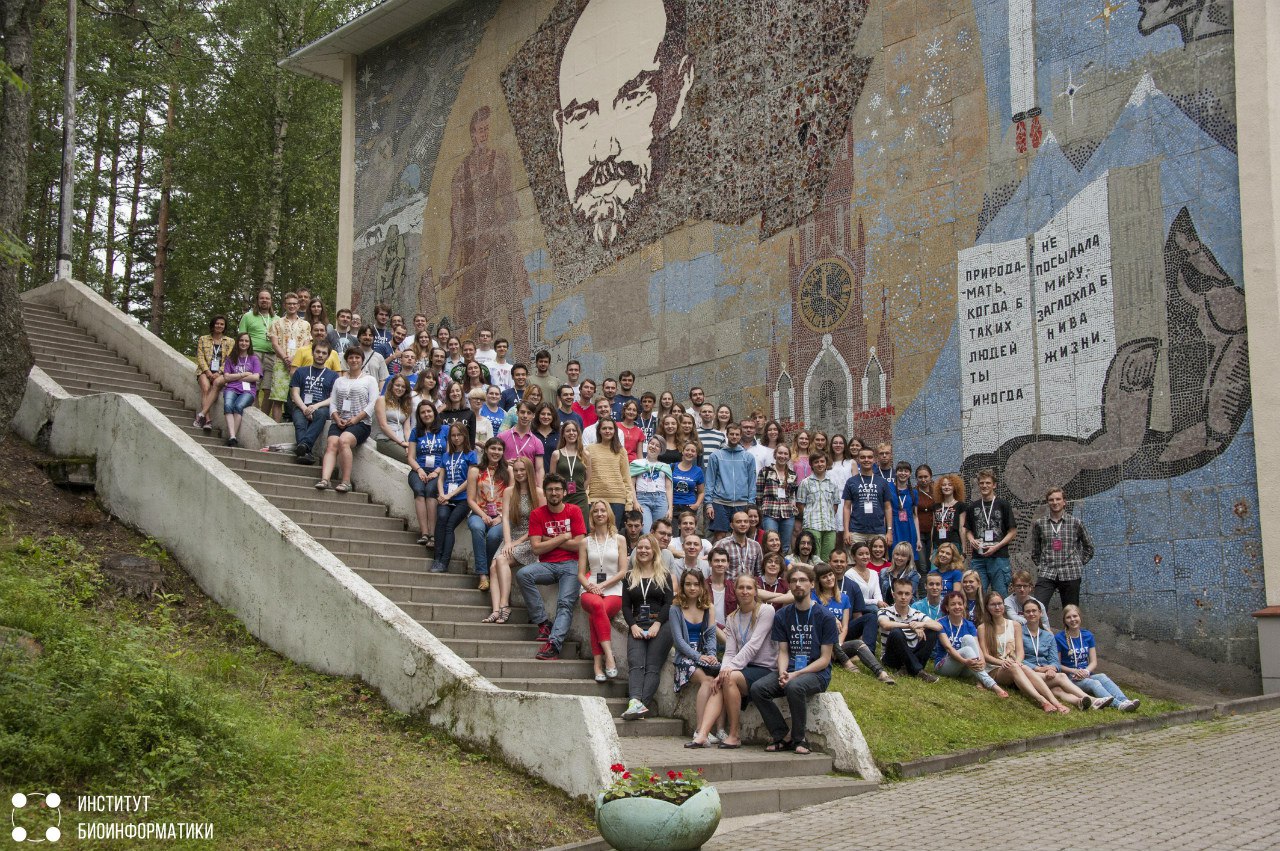
Every year 100 students and graduate students from all over Russia, the CIS and other countries come to the school. These are mainly biologists, physicians, programmers, mathematicians and physicists. During the week, participants immerse themselves in the world of bioinformatics: theywake up, attend lectures and seminars, talk with each other a lot and work on research projects.
')
Lectures at the school are read by leading Russian and foreign scientists, as well as researchers from biotechnology and bioinformatics companies.
This article contains lectures for two years of summer schools. Some lectures will be understood without additional preparation (marked with an asterisk "*"). Others are designed for those who have some understanding of molecular biology and programming. For convenience, the lectures are divided into five topics. Also in a short time (a separate post) lectures on statistics, immunology and metagenomics will appear.
In 2016, the school was supported by the companies JetBrains, RVK, BIOCAD, EPAM Systems and Parseq Lab. For which many thanks to them.
If you want to take part in the summer school 2017 - fill out the form on the school website , and we will notify you as soon as the acceptance of applications opens.
1. Sequencing technologies * (Pavel Dobrynin, FG Dobzhansky Center for Genomic Bioinformatics, St. Petersburg State University)
Video | Slides
Overview lecture on the formation and development of sequencing technologies: the use of NGS to solve various kinds of problems, the strengths and weaknesses of existing methods, as well as restrictions on their use. Prospects for the development of sequencing technologies.
2. Practical Bioinformatics: NGS data processing (Alexander Predeus, Institute of Bioinformatics)
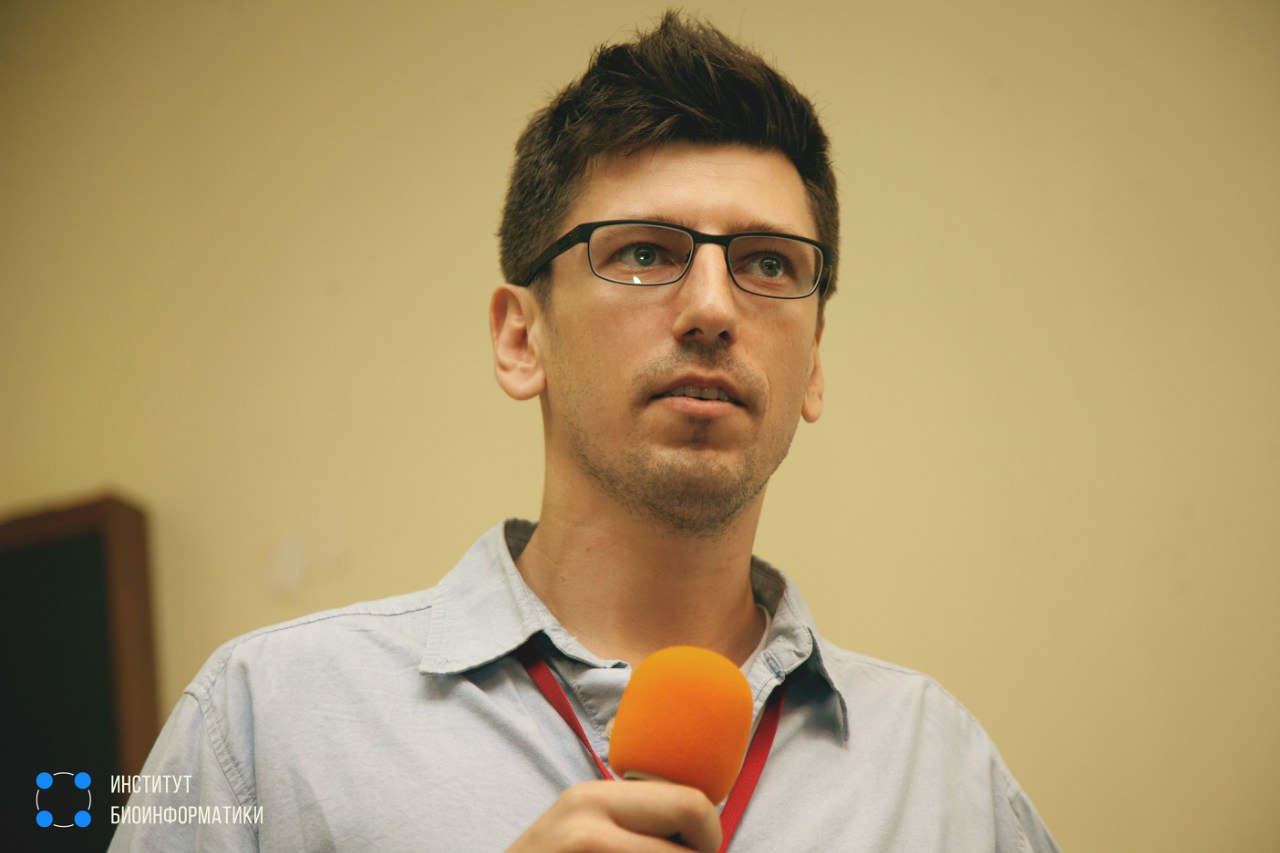
Video | Slides
The lecture discusses the main areas in which bioinformatics work in science and industry. The overwhelming majority of the tasks of bioinformatics can be divided into two large categories: processing experiments and predicting any properties of a biological system. The lecture covers in detail the tasks of the first category, or rather, the processing of NGS experiments, interaction with experimenters in your laboratory, and quality control.
3. Transcriptome: practical methods and algorithms used (Alexander Predeus, Institute of Bioinformatics)
Video | Slides
Transcriptome confidently took place in the list of the most popular tasks facing NGS-bioinformatics. Differential analysis of gene expression, clustering of expression data and interpretation of the data obtained in terms of metabolic and signaling cascades provide a wealth of information on almost any system. The lecture discusses the best pipelines, the main problem areas in the design of experiments and processing, as well as practical cases of successful application of transcriptome approaches.
4. Practical application of ChIP-Seq and related methods (Alexander Predeus, Institute of Bioinformatics)
Video | Slides
The methods of ChIP-Seq, as well as “genomic footprinting” (ATAC-Seq, FAIRE-Seq, DNase-Seq) are widely used to find mechanisms for the regulation of biological processes, in particular, transcriptional regulation. The potential space of the studied factors is very multidimensional, however, a selective approach allows obtaining rich information about regulation in the system on the basis of just a few experiments. The lecture tells about such approaches. By the example of conflicting modern theories, the main difficulties of interpreting regulatory information and ways to consolidate the results obtained are shown.
5. Application of HTS in the search for underlying causes of cancer (Konstantin Okonechnikov, German Cancer Research Center, DKFZ)
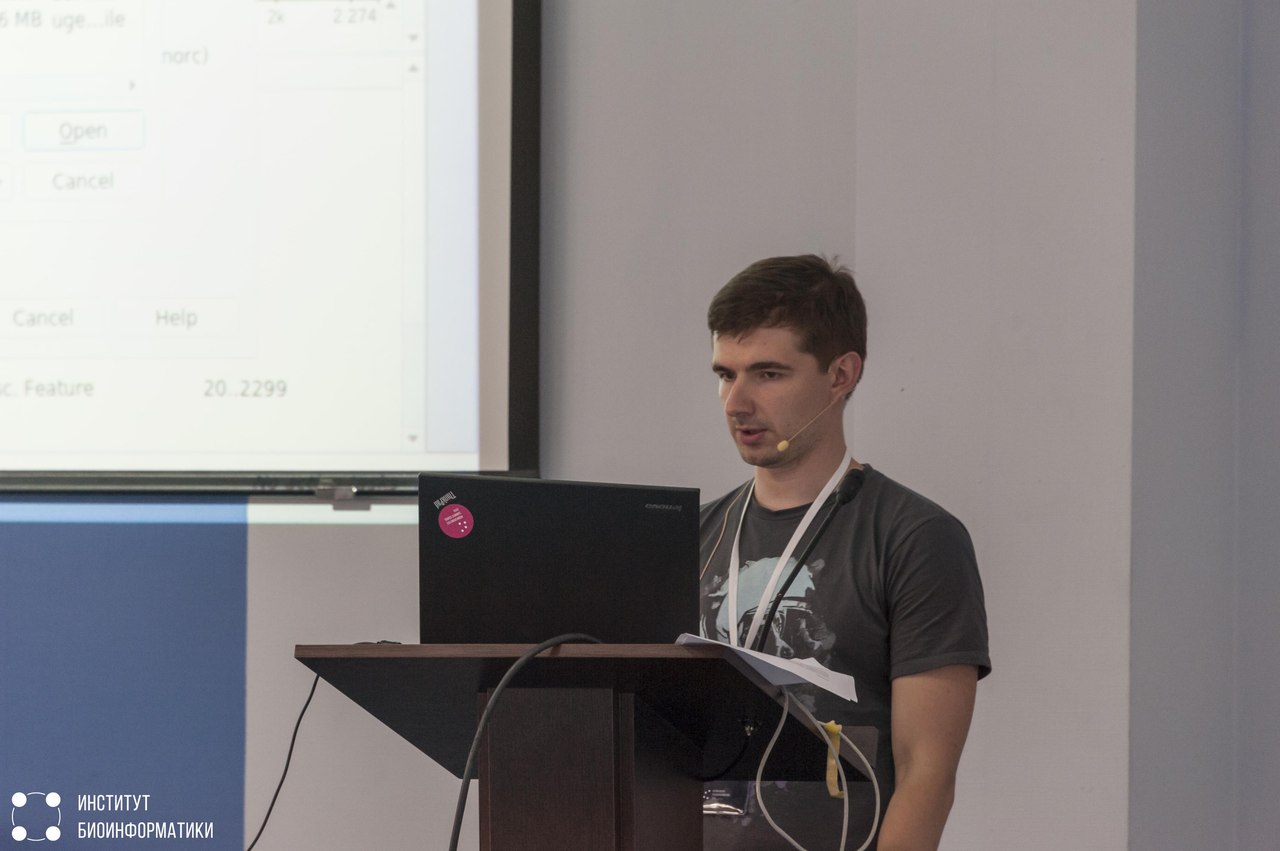
Video | Slides
High-throughput sequencing (HTS) technologies have become some of the most important and frequently used methods in molecular biology. Despite the fact that analyzing the results of HTS is a difficult task, there are a number of methods and tools that allow biologists and physicians to process this data without special bioinformatics training. This lecture describes how to use these methods and programs in practice.
6. Full-genome sequencing in the analysis of trajectories of child development (Elena Grigorenko, St. Petersburg State University, Baylor College of Medicine, Yale University, University of Houston)

Video | Slides
The lecture gives examples of the use of different types of full-genome sequencing in the context of studying typical (neurotypical) and atypical (neuroleptic) development trajectories. Apply data from sequencing of exome, methyloma, and genome to analyze developmental disorders (for example, language and speech disorders, behavioral disorders, and autism spectrum disorders).
7. Abstract MPS data target panel for the diagnosis of monogenic diseases (Tamara Simakova, Parseq Lab )
Video | Slides
High-throughput sequencing allows obtaining high-quality data on the sequence of nucleotides in the genome. In order to apply the results of the analysis in clinical practice, it is necessary to correctly identify genetic variants, to annotate and interpret them in the context of the disease under investigation and the guiding diagnosis. This stage is still a challenge, which is key to the effective use of the new technology.
8. Genome Assembly in Historical Perspective * (Mikhail Kolmogorov, University California San Diego)
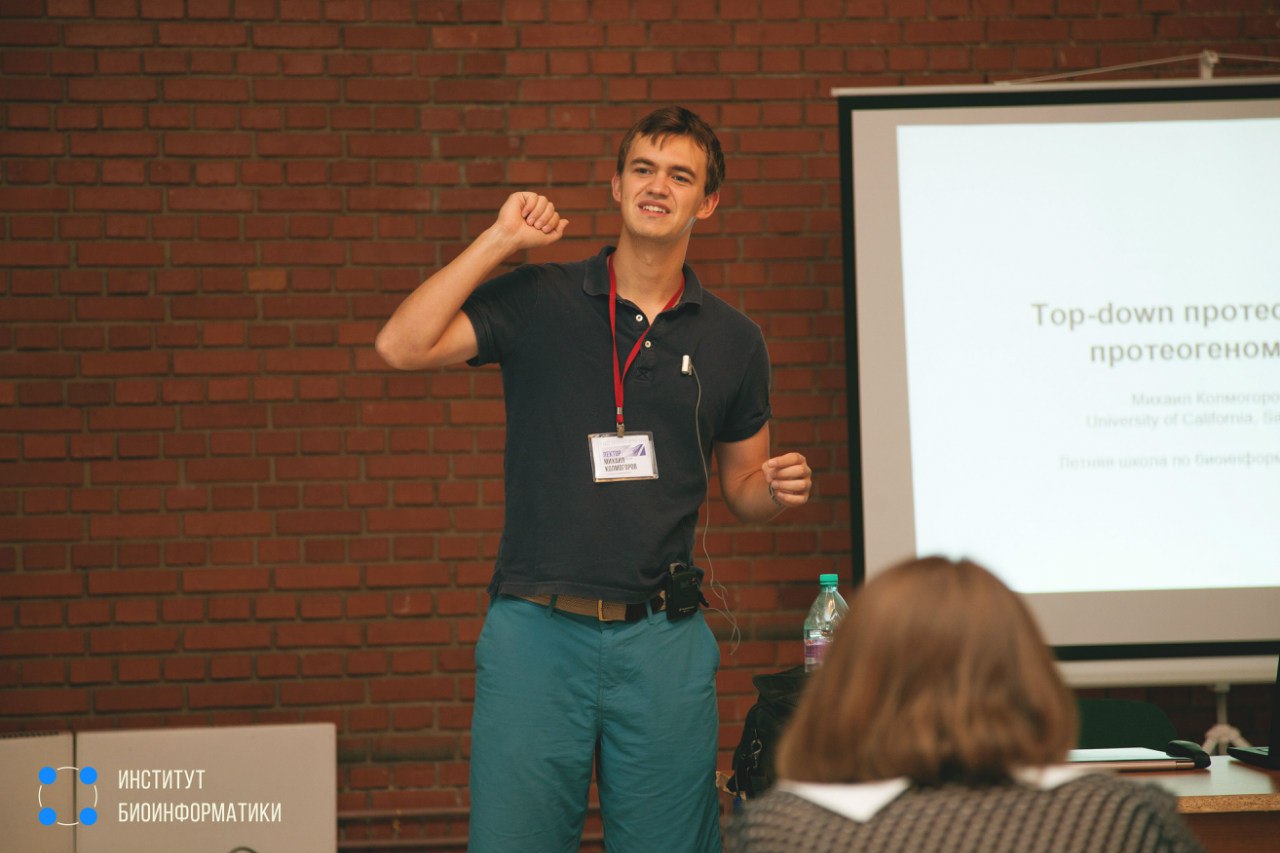
Video | Slides
The task of assembling the genome - one of the oldest tasks of bioinformatics - remains relevant today. Various algorithms and models quickly replace each other, keeping pace with developing biotechnologies and increasing computing power. The lecture tells the story of this task - from the first assembly of the human genome to the latest successes in the field.
9. Assembly of de novo genomes and transcriptomes (Artem Kasyanov, MIPT, IOGen RAS)

Video | Slides
The development of high-throughput sequencing technologies has led to a significant simplification of the sequencing and assembly of de novo nucleotide sequences of non-model species. The assembly of genomic and transcriptome sequences is gradually becoming a routine procedure. However, most genomic nucleotide sequences obtained using NGS are represented in the database as incomplete genome drafts.
10. Reference genome in the form of a graph as the “genomic passport” of humanity (Marina Zueva, EPAM Systems )
Video | Slides
The decoding of the human genome in 2003 was one of the greatest achievements of mankind. Since then, more than 250 000 thousand people have been sequenced, and this number doubles every year. The haploid genome does not adequately reflect the entire amount of rapidly growing information; the output is a reference in the form of a graph constructed in such a way that the genome of each person can be represented as a path in this graph.
The reflection of genomic information in a single data structure is a serious scientific challenge. The solution of this problem will bear fruit in various areas of modern bioinformatics, but above all in population genetics and the search for new mutations.
11. Molecular biology and evolution * (Nadezhda Markina, IBCh RAS)
Video | Slides
Introductory lecture on the basics of molecular biology and evolution for informatics and programmers. The lecture gives a chance to master the basic concepts that will be required for the further development of bioinformatics in general.
12. Basics of population genetics * (Mikhail Kolmogorov, UCSD)
Video | Slides
Population genetics studies the variability of organisms within a single population. The nature and dynamics of the observed mutations play an important role in understanding the development of the organism. The lecture describes the basic concepts and mathematical models used in population genetics, as well as the application of these models in real research.
13. The evolution of bacterial genomes (Mikhail Gelfand, Moscow State University, IITP RAS)
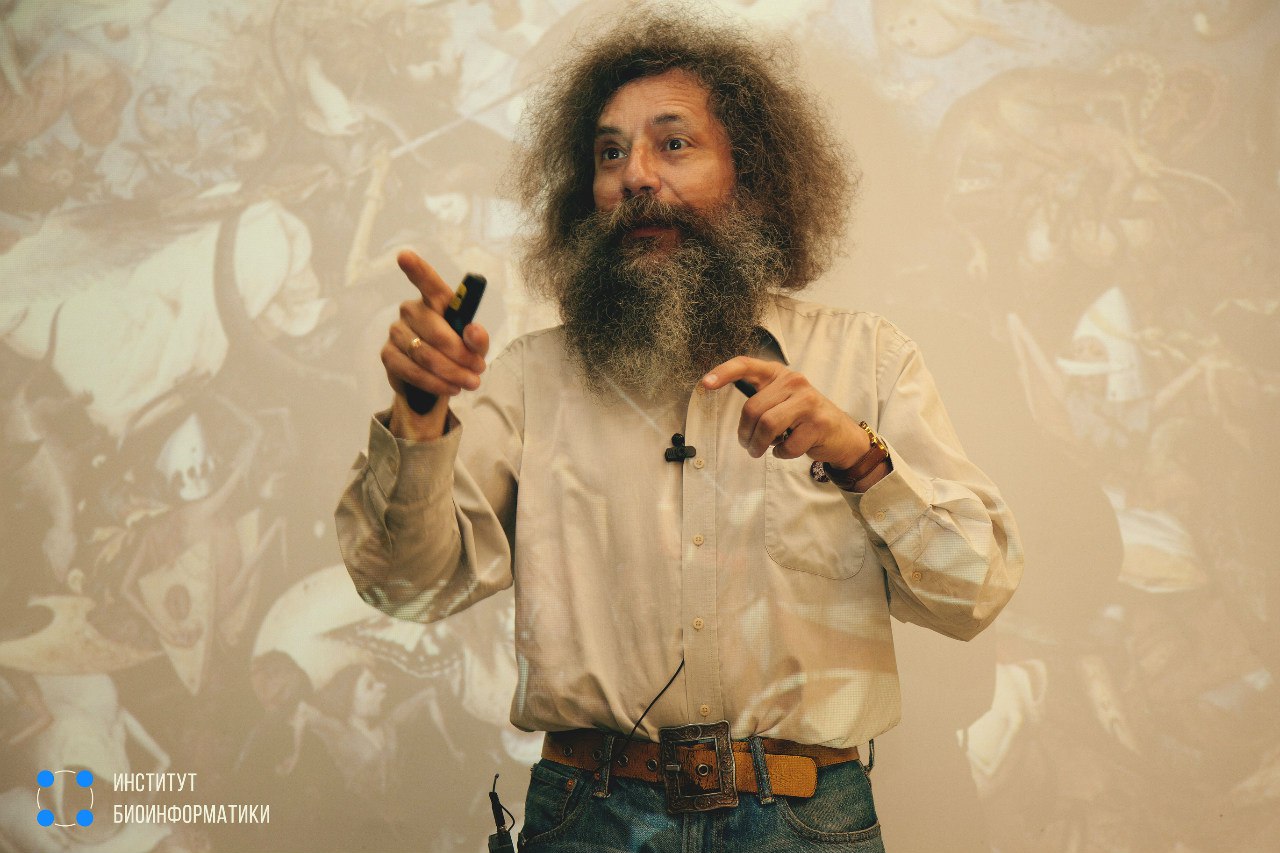
Video
The bacterial genome can be viewed at different levels: as a set of genes
(and discuss the evolution of pan-genomes), as a sequence of genes (and discuss genomic rearrangements), and as a sequence of nucleotides (and discuss homologous recombination). The lecture provides various examples and discusses the perspectives of a general theory.
14. The evolution of regulatory systems (Mikhail Gelfand, Moscow State University, IITP RAS)
Video
The evolution of bacterial regulatory systems includes a change in the composition of regulons, the restructuring of regulatory cascades and the co-evolution of transcription factors and their recognizable motifs in DNA. The lecture provides various examples and perspectives of this theory.
15. Recent advances in the analysis of evolutionary rearrangements (Maxim Alekseev, George Washington University)

Video | Slides
This lecture is devoted to the latest scientific advances in the analysis of evolutionary rearrangements. Genomic rearrangements are, figuratively speaking, genomic "earthquakes" that change the structure of chromosomes. The minimum number of rearrangements between two genomes (the so-called “genomic distance”) is a fairly accurate measure of the evolutionary distance between these organisms and is often used in comparative genomics. Despite the fact that there is a convenient Double-Cut-and-Join (DCJ) model for analyzing the most common genome rearrangements (reversals, translocations, divisions, fusions) and calculating the corresponding distance, this model does not take into account more rare, but “powerful” transposition rearrangement.
16. Why do people grow old and how does bioinformatics help in this? * (Andrei Afanasyev, CEO of iBinom, senior research scientist at the MIPT Genome Functional Analysis Laboratory)
Video | Slides
Overview lecture on the achievements of modern gerontology, problems and promising directions.
17. Secrets of brain aging (Elena Syugis, Quretec, University of Tartu)
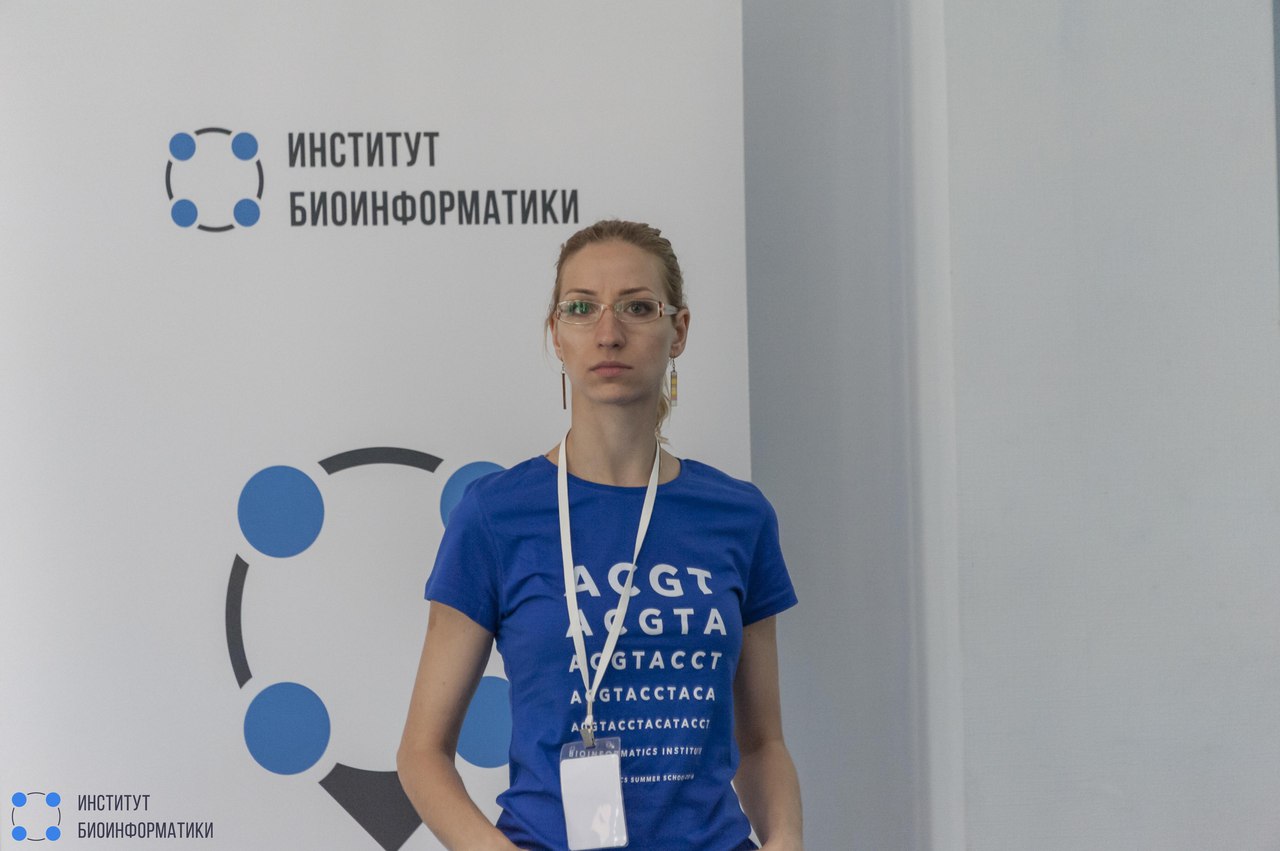
Video | Slides
A significant part of modern research is aimed at studying the molecular mechanisms of brain aging and the occurrence of neurodegenerative diseases, such as Parkinson's disease and Alzheimer's disease. The results of such experiments are accumulated in various public and private databases that are created to work effectively with certain types of biological data. However, the underlying mechanisms of neurodegenerative diseases are still poorly understood. This lecture discusses the creation of common, complex networks of interaction between individual mechanisms already described for creating a holistic picture in understanding neurodegenerative lesions.
18. World genetic and bioinformatics companies. And those who pretend to be them * (Andrey Afanasyev, CEO of iBinom, senior research scientist at the MIPT Genome Functional Analysis Laboratory)
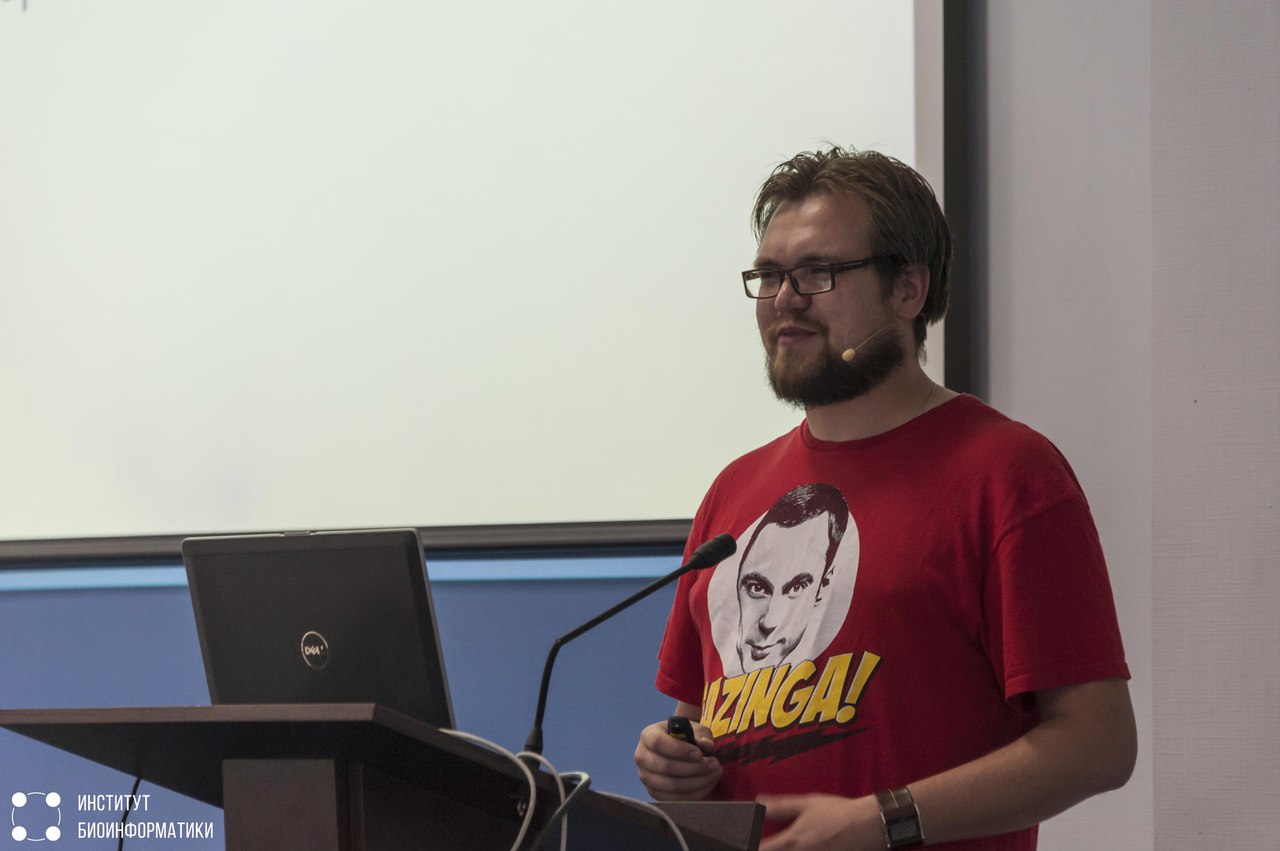
Video | Slides
Overview of the global market for bioinformatics and NGS. Trends and leading players.
And also a couple of words about how the venture industry works, and why Elizabeth Perrish and others like her appear.
19. What's hot: what do doctors with bioinformatics talk about at international conferences * (Andrey Afanasyev, CEO of iBinom, senior research scientist at the MIPT Genome Functional Analysis Laboratory)
Video | Slides
Review of speeches at TRI-Con, ASHG, AMP and NGS scientific conferences in medical genetics. The main issues of modern medical genetics and molecular diagnostics.
20. Modern methods of developing targeted drugs (Pavel Yakovlev, Director of Computational Biology, BIOCAD )
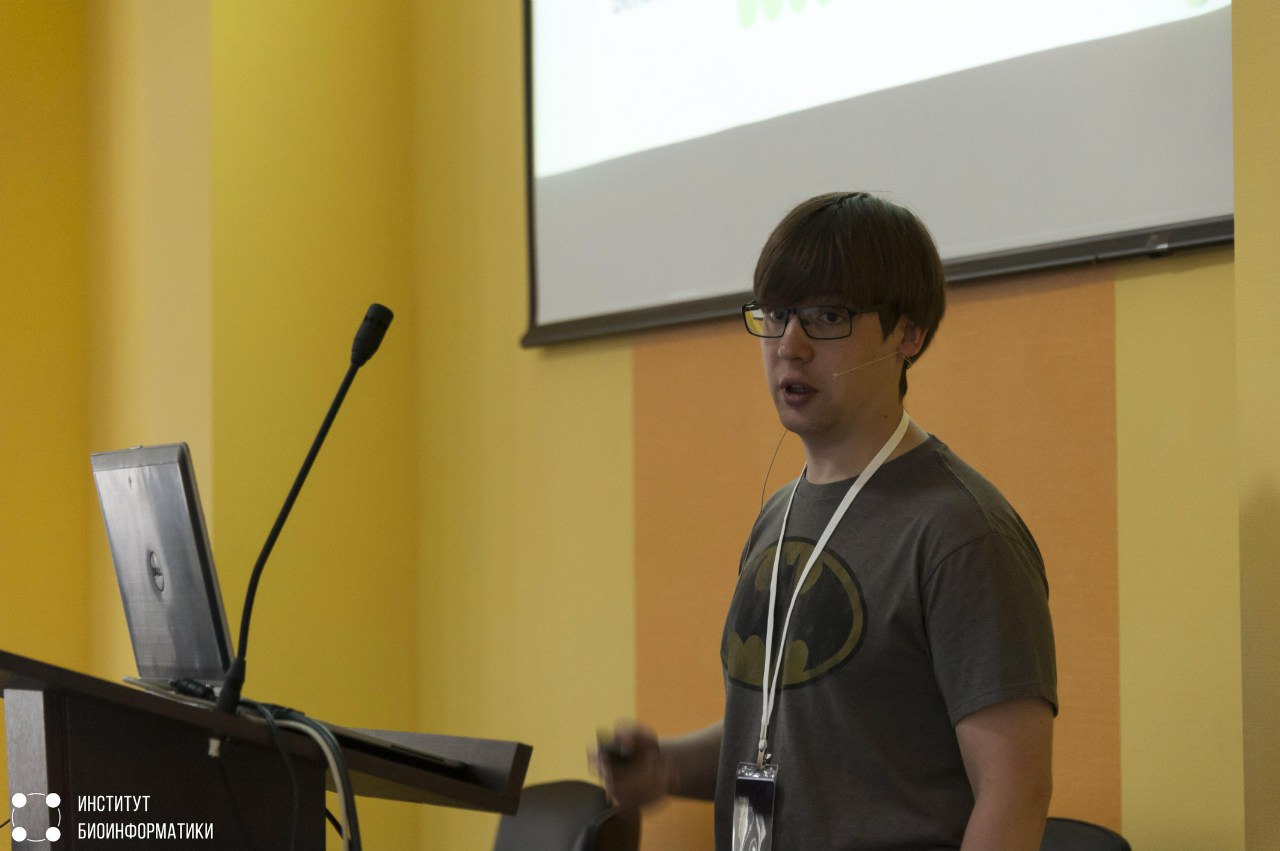
Video | Slides
The lecture is devoted to general issues and trends of modern drug development on the example of bioinformative company BIOCAD.

Introductory words about school
Every year 100 students and graduate students from all over Russia, the CIS and other countries come to the school. These are mainly biologists, physicians, programmers, mathematicians and physicists. During the week, participants immerse themselves in the world of bioinformatics: they
')
Lectures at the school are read by leading Russian and foreign scientists, as well as researchers from biotechnology and bioinformatics companies.
This article contains lectures for two years of summer schools. Some lectures will be understood without additional preparation (marked with an asterisk "*"). Others are designed for those who have some understanding of molecular biology and programming. For convenience, the lectures are divided into five topics. Also in a short time (a separate post) lectures on statistics, immunology and metagenomics will appear.
In 2016, the school was supported by the companies JetBrains, RVK, BIOCAD, EPAM Systems and Parseq Lab. For which many thanks to them.
If you want to take part in the summer school 2017 - fill out the form on the school website , and we will notify you as soon as the acceptance of applications opens.
High-throughput sequencing technologies (NGS), processing their data and applying the results in medical and scientific practice
1. Sequencing technologies * (Pavel Dobrynin, FG Dobzhansky Center for Genomic Bioinformatics, St. Petersburg State University)
Video | Slides
Overview lecture on the formation and development of sequencing technologies: the use of NGS to solve various kinds of problems, the strengths and weaknesses of existing methods, as well as restrictions on their use. Prospects for the development of sequencing technologies.
2. Practical Bioinformatics: NGS data processing (Alexander Predeus, Institute of Bioinformatics)

Video | Slides
The lecture discusses the main areas in which bioinformatics work in science and industry. The overwhelming majority of the tasks of bioinformatics can be divided into two large categories: processing experiments and predicting any properties of a biological system. The lecture covers in detail the tasks of the first category, or rather, the processing of NGS experiments, interaction with experimenters in your laboratory, and quality control.
3. Transcriptome: practical methods and algorithms used (Alexander Predeus, Institute of Bioinformatics)
Video | Slides
Transcriptome confidently took place in the list of the most popular tasks facing NGS-bioinformatics. Differential analysis of gene expression, clustering of expression data and interpretation of the data obtained in terms of metabolic and signaling cascades provide a wealth of information on almost any system. The lecture discusses the best pipelines, the main problem areas in the design of experiments and processing, as well as practical cases of successful application of transcriptome approaches.
4. Practical application of ChIP-Seq and related methods (Alexander Predeus, Institute of Bioinformatics)
Video | Slides
The methods of ChIP-Seq, as well as “genomic footprinting” (ATAC-Seq, FAIRE-Seq, DNase-Seq) are widely used to find mechanisms for the regulation of biological processes, in particular, transcriptional regulation. The potential space of the studied factors is very multidimensional, however, a selective approach allows obtaining rich information about regulation in the system on the basis of just a few experiments. The lecture tells about such approaches. By the example of conflicting modern theories, the main difficulties of interpreting regulatory information and ways to consolidate the results obtained are shown.
5. Application of HTS in the search for underlying causes of cancer (Konstantin Okonechnikov, German Cancer Research Center, DKFZ)

Video | Slides
High-throughput sequencing (HTS) technologies have become some of the most important and frequently used methods in molecular biology. Despite the fact that analyzing the results of HTS is a difficult task, there are a number of methods and tools that allow biologists and physicians to process this data without special bioinformatics training. This lecture describes how to use these methods and programs in practice.
6. Full-genome sequencing in the analysis of trajectories of child development (Elena Grigorenko, St. Petersburg State University, Baylor College of Medicine, Yale University, University of Houston)

Video | Slides
The lecture gives examples of the use of different types of full-genome sequencing in the context of studying typical (neurotypical) and atypical (neuroleptic) development trajectories. Apply data from sequencing of exome, methyloma, and genome to analyze developmental disorders (for example, language and speech disorders, behavioral disorders, and autism spectrum disorders).
7. Abstract MPS data target panel for the diagnosis of monogenic diseases (Tamara Simakova, Parseq Lab )
Video | Slides
High-throughput sequencing allows obtaining high-quality data on the sequence of nucleotides in the genome. In order to apply the results of the analysis in clinical practice, it is necessary to correctly identify genetic variants, to annotate and interpret them in the context of the disease under investigation and the guiding diagnosis. This stage is still a challenge, which is key to the effective use of the new technology.
Genome assembly
8. Genome Assembly in Historical Perspective * (Mikhail Kolmogorov, University California San Diego)

Video | Slides
The task of assembling the genome - one of the oldest tasks of bioinformatics - remains relevant today. Various algorithms and models quickly replace each other, keeping pace with developing biotechnologies and increasing computing power. The lecture tells the story of this task - from the first assembly of the human genome to the latest successes in the field.
9. Assembly of de novo genomes and transcriptomes (Artem Kasyanov, MIPT, IOGen RAS)

Video | Slides
The development of high-throughput sequencing technologies has led to a significant simplification of the sequencing and assembly of de novo nucleotide sequences of non-model species. The assembly of genomic and transcriptome sequences is gradually becoming a routine procedure. However, most genomic nucleotide sequences obtained using NGS are represented in the database as incomplete genome drafts.
10. Reference genome in the form of a graph as the “genomic passport” of humanity (Marina Zueva, EPAM Systems )
Video | Slides
The decoding of the human genome in 2003 was one of the greatest achievements of mankind. Since then, more than 250 000 thousand people have been sequenced, and this number doubles every year. The haploid genome does not adequately reflect the entire amount of rapidly growing information; the output is a reference in the form of a graph constructed in such a way that the genome of each person can be represented as a path in this graph.
The reflection of genomic information in a single data structure is a serious scientific challenge. The solution of this problem will bear fruit in various areas of modern bioinformatics, but above all in population genetics and the search for new mutations.
Bioinformatics in population and evolutionary genetics
11. Molecular biology and evolution * (Nadezhda Markina, IBCh RAS)
Video | Slides
Introductory lecture on the basics of molecular biology and evolution for informatics and programmers. The lecture gives a chance to master the basic concepts that will be required for the further development of bioinformatics in general.
12. Basics of population genetics * (Mikhail Kolmogorov, UCSD)
Video | Slides
Population genetics studies the variability of organisms within a single population. The nature and dynamics of the observed mutations play an important role in understanding the development of the organism. The lecture describes the basic concepts and mathematical models used in population genetics, as well as the application of these models in real research.
13. The evolution of bacterial genomes (Mikhail Gelfand, Moscow State University, IITP RAS)

Video
The bacterial genome can be viewed at different levels: as a set of genes
(and discuss the evolution of pan-genomes), as a sequence of genes (and discuss genomic rearrangements), and as a sequence of nucleotides (and discuss homologous recombination). The lecture provides various examples and discusses the perspectives of a general theory.
14. The evolution of regulatory systems (Mikhail Gelfand, Moscow State University, IITP RAS)
Video
The evolution of bacterial regulatory systems includes a change in the composition of regulons, the restructuring of regulatory cascades and the co-evolution of transcription factors and their recognizable motifs in DNA. The lecture provides various examples and perspectives of this theory.
15. Recent advances in the analysis of evolutionary rearrangements (Maxim Alekseev, George Washington University)

Video | Slides
This lecture is devoted to the latest scientific advances in the analysis of evolutionary rearrangements. Genomic rearrangements are, figuratively speaking, genomic "earthquakes" that change the structure of chromosomes. The minimum number of rearrangements between two genomes (the so-called “genomic distance”) is a fairly accurate measure of the evolutionary distance between these organisms and is often used in comparative genomics. Despite the fact that there is a convenient Double-Cut-and-Join (DCJ) model for analyzing the most common genome rearrangements (reversals, translocations, divisions, fusions) and calculating the corresponding distance, this model does not take into account more rare, but “powerful” transposition rearrangement.
Bioinformatics and aging
16. Why do people grow old and how does bioinformatics help in this? * (Andrei Afanasyev, CEO of iBinom, senior research scientist at the MIPT Genome Functional Analysis Laboratory)
Video | Slides
Overview lecture on the achievements of modern gerontology, problems and promising directions.
17. Secrets of brain aging (Elena Syugis, Quretec, University of Tartu)

Video | Slides
A significant part of modern research is aimed at studying the molecular mechanisms of brain aging and the occurrence of neurodegenerative diseases, such as Parkinson's disease and Alzheimer's disease. The results of such experiments are accumulated in various public and private databases that are created to work effectively with certain types of biological data. However, the underlying mechanisms of neurodegenerative diseases are still poorly understood. This lecture discusses the creation of common, complex networks of interaction between individual mechanisms already described for creating a holistic picture in understanding neurodegenerative lesions.
Modern bioinformatics and biotechnology market
18. World genetic and bioinformatics companies. And those who pretend to be them * (Andrey Afanasyev, CEO of iBinom, senior research scientist at the MIPT Genome Functional Analysis Laboratory)

Video | Slides
Overview of the global market for bioinformatics and NGS. Trends and leading players.
And also a couple of words about how the venture industry works, and why Elizabeth Perrish and others like her appear.
19. What's hot: what do doctors with bioinformatics talk about at international conferences * (Andrey Afanasyev, CEO of iBinom, senior research scientist at the MIPT Genome Functional Analysis Laboratory)
Video | Slides
Review of speeches at TRI-Con, ASHG, AMP and NGS scientific conferences in medical genetics. The main issues of modern medical genetics and molecular diagnostics.
20. Modern methods of developing targeted drugs (Pavel Yakovlev, Director of Computational Biology, BIOCAD )

Video | Slides
The lecture is devoted to general issues and trends of modern drug development on the example of bioinformative company BIOCAD.
Source: https://habr.com/ru/post/399843/
All Articles